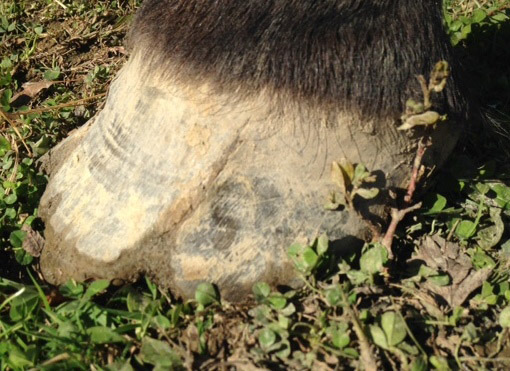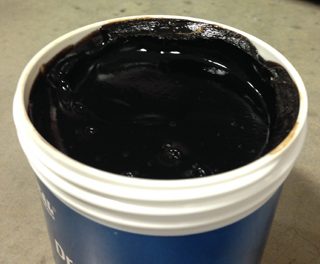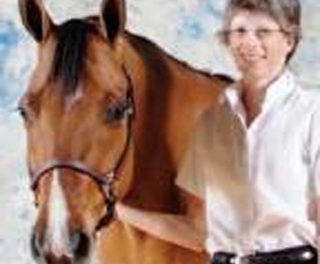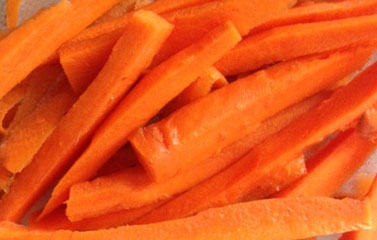The Way of Horses
 I received an email the other day from a horse owner wanting to know what supplement she could feed her horse to improve the condition of her horse’s hoof. Attached was a picture of the hoof.
I received an email the other day from a horse owner wanting to know what supplement she could feed her horse to improve the condition of her horse’s hoof. Attached was a picture of the hoof.
After playing “20 Questions” I determined the horse was in her late 20’s, has had the cracks for several years, was eating grass hay, received no additional grain or supplements, was not being ridden and was only trimmed two or three times a year.
Where to start?
The first step was to address the nutritional aspect of the problem. Without an analysis of the forage it would be difficult to scientifically determine what nutrients the horse was lacking.
I asked the owner to describe the hay. She said because of weather conditions over the last several years – a lot of rain, the hay has been very mature. It contained a lot of material the mare would not (or could not) eat. It did not smell sweet, was very brown and felt coarse to the touch. The bottom line – the nutritional quality of the hay was pretty poor.
Healthy hooves require adequate amounts of good quality protein, specifically the amino acids methionine, cystine and cysteine. (Amino acids are the building blocks of protein). Methionine is an essential amino acid…the horse must get it through diet. If an adequate amount of methionine is available the other two amino acids are produced within the body. This hay was not a good source of the much needed protein.
Healthy hooves also need biotin – a B vitamin. Biotin is provided by good quality forage, which this mare was not receiving.
Calcium and zinc are the important minerals for hooves. Calcium bonds one cell to another. Zinc is important to cellular division and growth, and is thought to improve the integrity of the hoof.
I recommended the horse owner locate a good quality feed, preferably one designed for an older horse. She was advised to introduce the product slowly to allow the horse’s digestive system to become used to the new diet, and to follow the feeding directions.
I then showed the picture to my farrier, Lance Johnstone and asked him for advice regarding the trimming of the hooves.
Lance explained there are three basic “rules” to maintaining a healthy hoof – providing the needed nutrients (diet), controlling the environment (terrain, moisture) and maintaining a good shoeing/trimming protocol.
The nutrition had been addressed so that left the final two components.
We weren’t going to be able to do much about the environment in which the horse was being kept. Lance explained it was a balancing act when managing the moisture coming into contact to the hooves. Too much water and they would become soft, losing strength, not maintaining their shape and possibly allowing a gap to develop along the white line. Too dry and the hoof loses elasticity, becomes brittle and crumbles away. The cycle of being wet during rainy conditions, and drying out during periods of dry weather is also detrimental. Providing a clean stall to allow the hooves to dry out during excessive rain, and then providing wet sand several times a week in which to stand during dry periods was advised.
A good frequent trimming schedule was highly recommended. The mare needed to be trimmed every five to six weeks. Even though there might not be much growth in that length of time, preventing the hooves from becoming excessively long would lessen the stress on the cracks.
There are basically three types of hoof cracks: complete (running from the coronet band to the ground), grass (running up from the ground in the lower part of the hoof) and sand (running down from the coronet band). Each is addressed differently regarding trimming, shoeing and care. The mare’s owner was advised to locate a reputable horse shoer in her location.
The mare’s owner had asked about putting oil or a dressing on the hooves. The hoof wall has a natural barrier that will not allow the penetration of oils. Hoof conditioners will not replace good nutrition, a desirable environment and proper hoof trimming/shoeing.
Lance also mentioned every horse owner should know how to pull a shoe and rasp a hoof. After the mare in question had sound hooves, the owner could rasp the new growth weekly, keeping the hooves in condition between farrier visits.
* Take the online course “Bits, Saddle Fitting and Hoof Balance” and work toward a Bachelor of Science Degree in Equine Studies, an Associate of Arts Degree in Equine Business Management, or certification as a Professional Horse Trainer, Riding Instructor or Stable Manager. Go to www.horsecoursesonline.com and get started today!





